Allium ‘Purple Sensation’
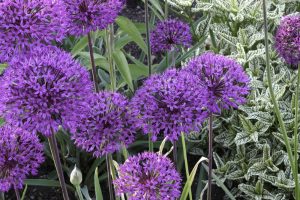 Allium ‘Purple Sensation’
Allium ‘Purple Sensation’
(AL-lee-um)
syn. Allium hollandicum ‘Purple Sensation’;
Allium aflatunense ‘Purple Sensation’
Family: Amaryllidaceae
Common name: ornamental onion
Zone: 4 – 10
Height: 28 – 32 in (70 – 80 cm)
Spread: 4 – 8 in (10 – 20 cm)
Aspect: sun; partial shade
Soil: average; humus-rich; well-draining
Water: moderate
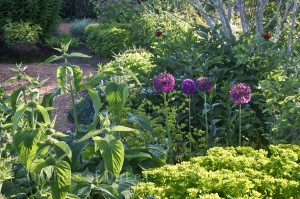 Description: A bulbous perennial with short basal leaves that die down by flowering time. Flower head consists of over 100 small, star-shaped purple-red blooms that form a globular starburst atop a sturdy green stem.
Description: A bulbous perennial with short basal leaves that die down by flowering time. Flower head consists of over 100 small, star-shaped purple-red blooms that form a globular starburst atop a sturdy green stem.
Special Notes: This allium looks great in a grouping of 7 – 9, or more. Recommend planting a low-lying perennial in front of the alliums to hide the less-than-stellar allium leaves. Flowers attract bees in good numbers. Deer and rabbit resistant. Can fall prey to the same diseases that afflict onions and garlic.
Caution: All parts are poisonous to humans in some degree.
Posted on February 12, 2023; updated on August 6, 2024
Anthriscus sylvestris ‘Ravenswing’
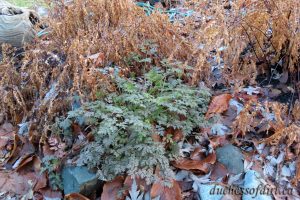 Anthriscus sylvestris ‘Ravenswing’
Anthriscus sylvestris ‘Ravenswing’
syn. Anthriscus ‘Ravenswing’
(an-THRIS-kus sil-VES-tris)
Family: Apiaceae
Common name: cow parsley, wild parsley, gypsy lace, Queen Anne’s lace, lady’s needlework
Zone: 5
Height: 3-4 ft (90-120 cm)
Spread: 1-2 ft (30-45 cm)
Aspect: full sun to partial shade
Soil: average; well-draining
Water: regular, moderate
Description: An herbaceous, upright, delicate-looking perennial. Attractive, deeply incised, rosy-purple leaves make a frothy appearance in late winter or early spring atop thin purple stems. Airy cymes of white flowers add to the delicacy of this plant in late spring through mid-summer.
Special Notes: Native across Europe, northwest Africa, western Russia and Asia Preference is for sunny to dappled shade locations; tolerant of poor soil conditions with moderate water. Drought tolerant once established. Cymes of white flowers attract pollinators and look good as cut flowers. Resistant to rabbits; not sure about deer. Slugs and snails may be a problem for young plants. Powdery mildew may be a problem in summer if in a crowded area with inadequate breeze.
Self-seeds so best to deadhead spent flowers before seeds drops. However, young seedlings are easily pulled in the spring before their tap root has developed. Removing older plants means digging down to get all of the root.
If you collect seed from this plant, it will need some vernalization (a cold period) in order to kick start germination. I find it much easier to let some seeds overwinter in place in the garden to sprout in the spring.
In our Zone 7a garden: This is one of my favourite plants for ease of care and bullet-tough constitution. Fresh foliage appears in late January, early February and handles surprise frosts well. An Australian nursery claims ‘Ravenswing’ is frost hardy to -10 °C (14 °F) and I believe it. There is never any frost damage on the early new growth after a late frost.
All of our ‘Ravenswing’ have come from a single plant on which I occasionally left a few flowers to go to seed. I have not experienced any problems with slugs or snails or rabbits. We are fenced for deer but one got in recently but either did not find my newly emerging ‘Ravenswing’ plants or chose not to taste them.
Posted on February 8, 2024; updated on August 6, 2024
Alchemilla mollis
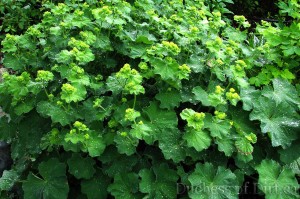 Alchemilla mollis Family: Rosaceae
Alchemilla mollis Family: Rosaceae
(al-kem-ILL-ah MAWL-iss)
syn. Alchemilla vulgaris
Common name: lady’s mantle
Zone: 3 – 8
Height: 18 – 24 in (45 – 60 cm)
Spread:18 – 24 in (45 – 60 cm)
Aspect: full sun; partial shade
Soil: average
Water: moderate
Description: An herbaceous perennial with good ground-covering foliage that forms a neat mound. Soft, pale grey-green rounded leaves are lobed and have crinkled edges. Airy sprays of tiny greenish-yellow flowers from spring to mid-summer.
Special Notes: Native to Greece, Turkey and Caucasus. The 2 – 4 inch (5 – 10 cm) leaves hold small droplets of water and dew. Good cut flower; dries well for floral arranging. Prolific self-seeder. Cut entire plant back to ground when flowers are spent and before they set seed. Relatively pest and disease free. May get powdery mildew in hot humid climate. Drought tolerant. Propagation by seed; division in spring or autumn.
RHS Award of Garden Merit 1993
Posted on December 17, 2012; updated on August 6, 2024
Anemone x hybrida ‘September Charm’
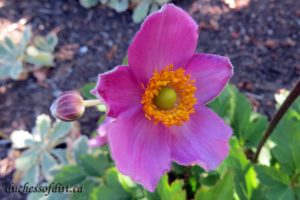 Anemone x hybrida ‘September Charm’
Anemone x hybrida ‘September Charm’
(ah-NEM-oh-nee ex HY-brid-ah)
Syn. Anemone hupehensis var. japonica ‘September Morn’
Family: Ranunculaceae
Common name: Japanese anemone; windflower
Zone: 4 – 8
Height: 24-36 in (60-90 cm)
Spread: 24 in (60 cm)
Aspect: full sun; part shade
Soil: average; well-draining
Water: moderate
Description: An erect, fibrous-rooted, spreading herbaceous perennial. Height is usually two to three feet (60 – 90 cm), but has been known to reach four feet (120 cm). Single, branching, wiry stem rises above a dark green mound of trifoliate leaves. Each branch extending from the central stem supports a 2 – 3 in (5 – 7.5 cm) diameter flower of typically five purely delightful silver-pink petals, blushed with dark rose shading, surrounding a central grouping of bright yellow stamens.
Special Notes: A garden hybrid from suspected parentage of Anemone hupehensis var. japonica and Anemone vitifolia. With a bloom period stretching from mid-August through to October, this is a wonderful flowering perennial for late season interest in the garden.
Since the flowers are sterile, the plant increases from its fibrous roots which may be a problem for some gardeners. Spread is not so quick, however, that the plant cannot be kept within boundaries using a sharp spade to curb the expansion and pulling up the wandering offspring.
Pot up the offshoots to share with friends and fellow gardeners…or dry them out in a hot sun to kill them before adding them to your compost. But do make sure the unwanted plants are clearly expired before you throw them into your compost bin!
In our Zone 7a garden: In spite of this perennial being a spreader, we do enjoy its presence in our garden. The flowers are a welcome addition and even though the flowers are purported to be sterile, I have seen various winged insects on the bright yellow stamens. There must be something beneficial buried in there for them which is an attractant.
Royal Horticultural Society Award of Garden Merit (AGM) 1993
Posted on October 4, 2017; updated on August 6, 2024
Ajuga reptans BLACK SCALLOP
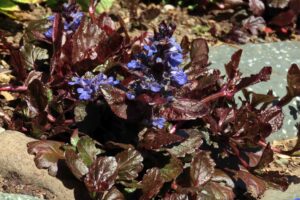 Ajuga reptans BLACK SCALLOP
Ajuga reptans BLACK SCALLOP
(ah-JEW-gah REP-tanz)
syn. Ajuga reptans ‘Binblasca’ PBR
Family: Lamiaceae
Common name: bugleweed; carpet bugleweed
Zone: 4 – 9
Height: 3 – 6 in (7.5 – 15 cm)
Spread: 6 – 24 in (15 – 60 cm)
Aspect: sun; partial shade
Soil: fertile; well-draining
Water: moderate
Description: An evergreen groundcover with glossy, dark maroon-purple to almost black, scalloped-edged leaves and a dense habit. Short, upright, spikes of dark violet, fragrant flowers four to six inches tall (10 – 15 cm) appear in mid- to late spring.
Special Notes: The genus Ajuga is native to Europe. BLACK SCALLOP is a mutation of Ajuga reptans ‘Braunherz’, discovered in an in-vitro nursery laboratory in 1998 and subsequently isolated to be developed and introduced as a new cultivar, Ajuga reptans ‘Binblasco’ PBR. U.S. Plant Patent was issued in June 2005. (PBR – Plant Breeder Registration)
BLACK SCALLOP tends to have a more compact habit than some of the other Ajuga cultivars. Plant where it will get more sun for deep, rich foliage colour but plants will require watering more often. In hotter climates, give it a little more shade from the sun.
Propagate by cutting the stolon, or plantlet, growing out from the mother plant to start a new plant. BLACK SCALLOP does not come true from seed.
Crown rot can be a problem if ajugas are allowed to grow too densely. Divide clumps every few years to thin the planting out. Aphids, slugs, snails and whiteflies can also be occasionally problematic. And while it is not unheard of for cucumber mosaic virus and tobacco mosaic virus to attack ajugas, there have been no reports of these viruses found on BLACK SCALLOP. However, remove the plants if you see these viruses and bag them for the garbage.
In our Zone 7a garden: We now have a few patches of BLACK SCALLOP in our landscape and we love them! Absolutely the best-behaved ajuga to plant in your garden for its dark leaves and dark violet flowers.
Posted on February 3, 2021; updated on August 6, 2024
